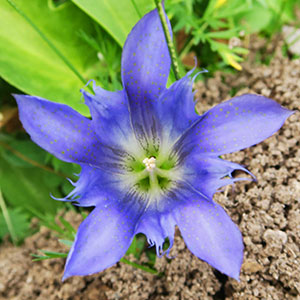Gentiana newberryi
Gentiana nivalis
alpine gentian, Newberry's gentian
gentiane des neiges, snow gentian
1–5, arising laterally below rosettes, from a stout tap root, tufted, decumbent.
1–10, ascending to erect, simple or few-branched.
basal and cauline;
blades of basal rosette and proximal cauline leaf blades widely spatulate to obovate or oblanceolate, 0.8–5 cm × 2–25 mm, apex obtuse or mucronate, at least these leaves with blades less than 6 times as long as wide, distal cauline leaves few, with blades oblanceolate to lanceolate or linear, 2–5 cm × 2–5 mm, apices acute.
basal and cauline;
cauline ± evenly spaced;
basal blades elliptic to obovate, 0.5–1.2 cm × 2–8 mm, apex obtuse;
cauline blades ovate to lanceolate, 0.3–1.2 cm × 2–6 mm, apex obtuse to acute.
terminal, flowers usually solitary, occasionally 2 or 3.
solitary flowers at ends of main axis and branches and in axils, branches of largest plants thus forming cymes.
calyx 14–30 mm, lobes linear to narrowly ovate, (4–)6–12 mm, margins not ciliate;
corolla white or blue, campanulate, open, 23–55 mm, lobes spreading, elliptic-obovate, 7–17 mm, free portions of plicae divided into 2 triangular, serrate to lacerate segments;
anthers distinct.
calyx (8–)11–16 mm, lobes linear-lanceolate, 2–6 mm, margins not ciliate;
corolla deep blue or occasionally white, salverform, open, (11–)17–25 mm, lobes spreading, ovate-elliptic, 3–6 mm, plicae small, ± triangular, distally bifid;
anthers distinct.
winged.
not winged.
= 14 (Iceland, Europe).
Gentiana newberryi
Gentiana nivalis
Varieties 2 (2 in the flora).
The two varieties of Gentiana newberryi intergrade extensively. The most distinctive form of var. newberryi, with relatively tall stems and medium to deep blue corollas, occurs in the northern part of the range of the species, from the Klamath and White mountains of California north into Oregon. Plants most clearly referable to var. tiogana prevail in the southern part of the range of the species, from Butte County south to Inyo and Tulare counties, California. In the central part of the range of the species, plant size and corolla color are less consistently correlated, with occasional plants combining low stature with deep blue corollas or tall stems with predominantly white or pale blue corollas. In that part of the range, corolla color may be highly variable within a single population.
The leaves of Gentiana newberryi are thick-textured and distinctively concave, usually spoon-shaped, when fresh. Narrower leaves sometimes occur in var. tiogana, but many plants of that variety have widely spatulate leaves like those of var. newberryi.
(Discussion copyrighted by Flora of North America; reprinted with permission.)
Gentiana nivalis is found in arctic and alpine regions of Europe and western Asia.
(Discussion copyrighted by Flora of North America; reprinted with permission.)
1. Corollas medium to deep blue with greenish to dark purple lines abaxially on and below lobes, usually 35–55 mm. | var. newberryi |
1. Corollas white to pale blue except for greenish to dark purple lines abaxially on and below lobes, usually 23–42 mm. | var. tiogana |


